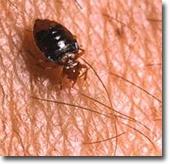Bed Bug Overview
 Eagle Pest Services has been providing the Metro D.C. area for years with our expertise in pest control. In doing so, we have accumulated the skill and knowledge to handle common household pests, including bed bugs. We are fully licensed and ready to serve any commercial or residential building infested with bed bugs.
Eagle Pest Services has been providing the Metro D.C. area for years with our expertise in pest control. In doing so, we have accumulated the skill and knowledge to handle common household pests, including bed bugs. We are fully licensed and ready to serve any commercial or residential building infested with bed bugs.
History of Bed Bugs
Bed bugs were a big problem in the early years of America. After WWII, however, the extreme pesticides managed to dwindle their numbers down to nearly a mere recollection in children's nursery rhymes. During the last decade, bed bugs are fast becoming a serious infestation problem. But with Eagle Pest Services, bed bugs are successfully terminated.
What do Bed Bugs Look Like?
Bed bugs are a brownish color, with bodies shaped like an oval and are flat. They are fairly tiny insects and they thrive on the blood of humans and animals. After they have feasted, their bodies swell and turn a reddish color. Bed bugs are flightless, but are quick and agile.
Itchy Bed Bug Bites
Before bed bugs reach adulthood, they are known as nymphs, and will shed their skin in 5 different cycles, requiring a sizable feeding before each shedding. If the bed bugs are living prestigiously, they can develop within a few months and produce 2-3 generations by the end of the year. Though they can be an annoyance, their bites have not been known to transmit any diseases. Bed bugs are nocturnal, and choose to feed on their slumbering prey. Their red, itchy welts can be mistaken for mosquito bites. Generally, their bites are found along the arms and shoulders, and are found in a lined pattern. There are a few noteworthy signs you have a bed bug pestilence problem. They include the following:
- Tiny blood stains adorning your sheets and pillowcases.
- Rusty looking spots, from their excrement, that could be found along your bedding, mattresses, walls, or throughout the room where they may have traveled.
- A pungent musty smell, that resonates from a bed bug's scent glands.
Where do Bed Bugs Live & Hide?
Due to their tiny size, bed bugs have the ability to hide in crevices and small cracks. Mattresses, box springs, head boards, undisturbed piles of clothes, closets, or other furnishings are prime sites. Along with hiding in the bedroom, bed bugs can be everywhere. They will often travel on a person or their clothes and luggage, and can be found in public transportation, airplanes, hotels, motels, movie theaters, schools, medical institutes or any place that services the general public. Due to their tiny size, and quick movements, bed bugs can be very difficult to find, and effectively terminate. Needing not only a professional pest control service, but one who has the training to efficiently destroy the bed bugs.
Bed Bug Extermination
In commercial spaces and residential homes in the Metro D.C. area, Eagles Pest Services is the leading authority in detecting bed bugs and efficiently removing them. With periodic visits and consultations on prevention, we can help you keep them out. Our specialists have been masterfully trained to fully execute the methods and techniques necessary for successful bed bug removal. Call us today to schedule your appointment!
An infestation of bed bugs is NOT evidence of unclean or unsanitary living areas. World class hotels have reported bed bug infestation in recent years perhaps due to the increased domestic and international mobility of society in the past few decades.
Commonly, the first sign of bed bug infestation is the appearance of small brownish or reddish dots on bed linens. These are fecal spots or droppings on the surface of linens from these bugs. Occupants may also notice swelling where they have been bitten.
Control
The first step of control is to have a professional thoroughly inspect the area. This inspection is required to determine the places where the bed bugs are living. Once the inspection is complete, the pest control professional will determine the proper type of control technique; treat the area and most likely return for a follow up inspection.





